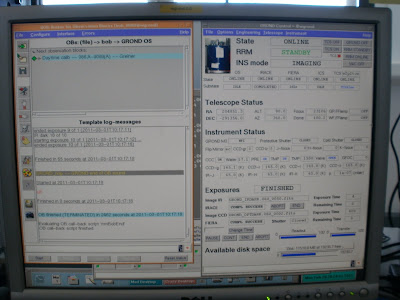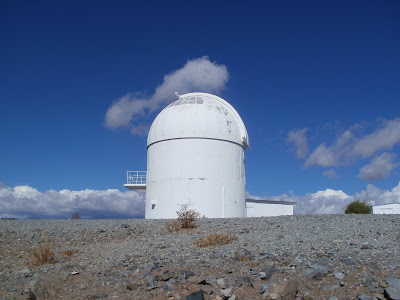GROND was built because GRBs are random events and so you don't know when they will happen. There is a satellite in space called Swift which constantly watches the sky waiting for a flash of light from the GRB. It then informs all ground based telescopes of the position of this flash, so instruments like GROND can then start to look for them.

GRBs are special in that their brightness changes over time (other stuff does too, like supernovae, but they aren't as bright), usually getting dimmer by huge amounts in a small space of time. So by taking pictuers over time you can find things out about the physics behind this phenomenon.
GROND is mounted on the 2.2m telescope at La Silla, which you can see below (behind the blue frame on the side - you can see the red cap of GROND's pump).

For perspective of size I used my unknowing colleague:

Normally the telescope is used with 2 other instruments (WFI and FEROS) by visiting astronomers. You can see them below, the silver cylinder and the big box.

But when there is a GRB a special mirror diverts the light of the telescope onto GROND. The images taken are then transfered to a pipeline machine which then processes the images and allows numbers to be taken from them to allow some physics to be done. The pipeline machine (just a computer, doesn't look as special as it is):

It works out that we can only use 15% of the visiting astronomer's time, which can lead to them getting pretty annoyed because they don't get explicitly told until they arrive. One of these days I can see an astronomer killing me :).
Some other random parts of the telescope, the base of the telescope which is under the floor of the whole telescope structure (stuff to do with movement of the telescope, hydrolics and oil pipes and other weird stuff I have no idea about):

The control computer for the different imaging units of GROND (reminds me of 24 where the bad guy always went to the server room and opened a terminal to screw over Jack Bauer):

The control units for the cooling (by vacuum) of the GROND imaging chips (the optical and NIR chips need to be kept at different temperatures. First the whole unit is cooled, but this is a little too cold for the NIR, which are then heated....)

For anyone overly interested (and slightly sad), I believe this is the pump section of GROND:

The flat screen. This is used to shine a light on when the weather is cloudy to take what are called 'sky flats'. Sky flats are

One of the most interesting and stressful parts is that GROND is owned by the Max Planck Institute. Because of this, ESO (European Southern Observatories) who run and maintain the telescopes, refuse to run/maintain GROND. This means that I (including all the other GROND team) have to maintain and run it. Usually there is a GROND member here for 3 weeks at a time and they come every 3 months. I've been three times and so far I have enjoyed it, mainly due to the fact that I haven't broken it (too badly...).


































